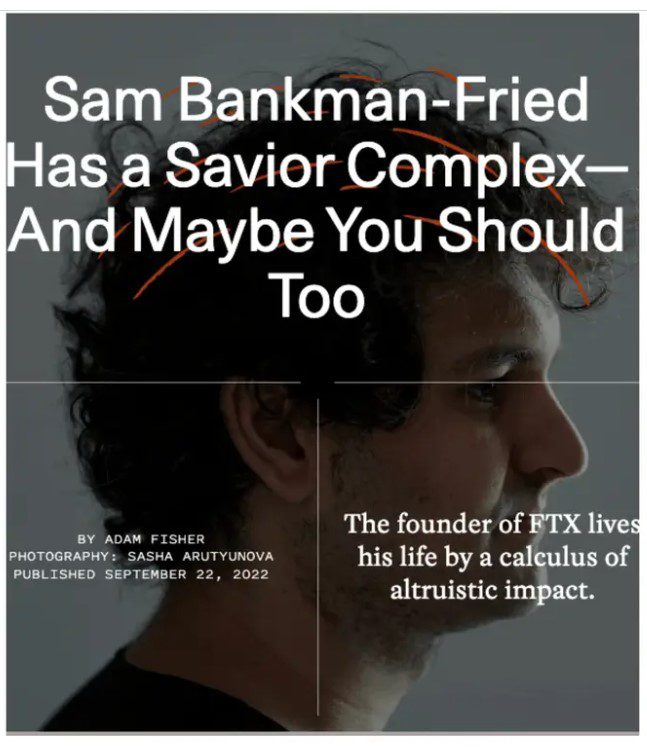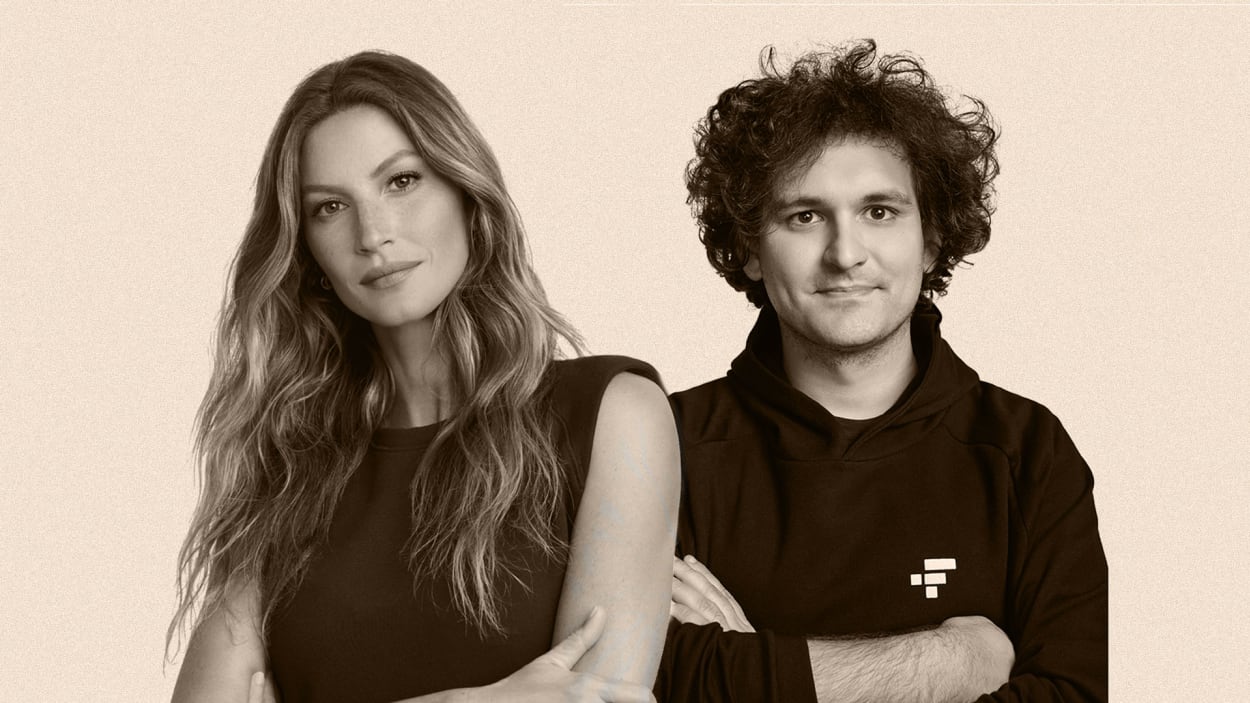Sam Bankman-Fried, FTX and the Demise of the Cool Kids

Investors with money sitting on the sidelines, listen up.
I’m on to the next big thing and need capital.
The total addressable market is every single human on the planet. The vision is to change the future of money by creating the real super app, using a new form of currency that allows every single person to do anything they want inside of it: send money, trade, buy things, invest, borrow — you name it.
Actually, “super” really understates its potential, given the fact that it will rewire the financial services ecosystem worldwide for every single person. And at the same time, the business will use its profits to fund important social causes: eliminating world hunger, poverty, the climate crisis — you name it.
From a regulatory perspective, it will be pretty much “Goldilocks perfect,” checking the necessary regulatory boxes in the right jurisdictions to protect consumers — even though that’s not how things operate today. We’re following the tried-and-true startup credo by asking for forgiveness rather than permission, even though we are moving billions of dollars of other people’s money. Yes, we are domiciled offshore, but the weather is so much better here — plus, we can try new things without having to worry too much about the regulators shutting us down before we get momentum.
To be clear, we’re profitable — making money hand over fist today. Well, maybe not as much as we did a year ago — but whatever, that’s life in crypto. You just never know when you might need a billion or two for that rainy day, so we’re hoping you’ll pony up.
I sincerely hope you don’t ask too many questions about an independent board — I don’t have one — nor require my CFO to be part of any diligence calls, since I don’t have one of those, either. I do have a bunch of smart, young, dedicated, workaholic traders piled into the same room who all work, live and eat together. Most importantly, I have that vision thing — based entirely on crypto, which all of you know is the future. And even if you don’t, you’ll probably be too embarrassed to ask the tough questions and push back anyway.
So … you in?
What you just read is my cynical take on Sam Bankman-Fried’s Series B pitch to the Sequoia partners via a Zoom call in July of 2021, which I based on the thirteen-thousand-word SBF profile piece published by Sequoia describing it. Yes, I took some liberties — but scarily, not too many.
Read that profile and you’ll understand why the implosion of SBF and FTX and the crumbling of the crypto ecosystem to follow should take no one by surprise. The piece is no longer on the Sequoia website, but an archived copy can be found here.
The Crypto Wunderkind

Cover of the 13,000-word Sequoia profile
The Sequoia profile, one of many puffed-up pieces published about SBF and FTX published over the last seven months or so, is breathless in its portrayal of SBF, FTX and the Sequoia’s team conviction that both would change the financial services world forever.
“Am I talking to the world’s first trillionaire?” the author asks a Sequoia partner who replies, “Yes, I think [SBF] has a real chance at that.”
During the July investor pitch, which resulted in a Series B raise of $1B — boy, were they “in” — the partners seemed obsessed with the fact that SBF was answering their questions while in the middle of playing a video game. A multitasking genius, he was called, a “10 out of 10.” “Goldilocks perfect” is the term used to describe the regulatory posture that FTX was pursuing, with “no concerted effort to skirt the law.”
It gets better.
The story concludes with the author attributing the FTX competitive advantage to its “ethical behavior” — the Effective Altruism (EA) thesis that would plow profits back into projects that would save the world. The utilitarian lifestyle of SBF and his team, the author implies, would be the FTX north star and keep it on the right path.
“I know who I’d rather trust my money with: SBF, hands-down. And if he does end up saving the world as a side effect of being my banker, all the better,” is how the story, published on September 22, 2022, ends.
That conclusion is remarkable because it comes after the author details SBF’s efforts to open a foreign bank account in Japan when launching Alameda Research, the entity that made a business monetizing the spread between bitcoin prices in the U.S. (lower) and Japan/South Korea (higher) — at the time, anyway.
As any FinTech that’s tried knows, getting a bank account in a foreign country is hard, by design — particularly so when crypto is involved, given the KYC, AML, citizenship rules, caps on withdrawals and central bank monetary controls. Undaunted, the story describes how SBF tapped an EA “tribe” member in Japan to help. As a Japanese citizen, the story goes, SBF’s “secret weapon” persuaded “the [only] one obscure, rural” financial institution in Japan to agree to move funds in and out of the Alameda bank account. For a fee, of course.
No wonder the story was taken down.
Are You In?
Sequoia was far from the only investor snookered by SBF, FTX and his vision for the future.

Vogue spread from April 2022 featuring Gisele Bundchen with Sam Bankman-Fried
A slew of well-respected investors lined up to give him money — on eye-popping valuations.
Celebrities were captivated by his “altruistic” mission: to make FTX successful just so he could give the money all away. (Or most of it, depending on who asked the question and when.) They wanted to be part of the EA movement.
It was SBF’s commitment to give one billion dollars to charitable causes between April 2022 and April 2023 that persuaded Gisele Bundchen to serve as FTX’s Head of Social and Environmental Initiatives. In April 2022, she and SBF were featured together in a full page spread in Vogue to appeal to female fashionistas who wanted to save the world and expand SBF’s reach to the fashion brands. Taking part meant “getting in” on FTX and crypto.
“Are you in” was the tag line of the commercials that Bundchen and her then husband Tom Brady appeared in when first promoting the FTX app in the Fall of 2021. “This is big,” Bundchen exclaimed in those ads. A year later, a commercial featuring Brady using a flame thrower to thaw Bitcoin from a block of ice hyped the FTX app as the antidote to the crypto winter.
https://twitter.com/i/status/1543965253523881986
They were far from the only celebrities lured by SBF’s persona: a cool kid, but not a slick and flashy cool kid. A smart kid who drove a Toyota Corolla, who seemed so much smarter than the average cryptopreneur. One motivated by doing good things, working 24/7/365 to pull it off without ever being pressed on the important details.
The crypto savior, the white knight, the J. P. Morgan of our times.
Please Don’t Ask, So I Don’t Tell
SBF interviews were softballs, even by the most respected journalists and public figures. No one asked tough questions, and no one followed up when the answers to quasi-tough questions didn’t make any sense.
For example:
When SBF was asked in September of 2022 how much he had given away, the answer was vague: “I think $100M,” he replied, without saying specifically what charities got his millions.
There was no follow-up asking who, when and how much.
When David Rubenstein asked SBF in a September 1, 2022 interview how he funded the bailout of Voyager and BlockFi, here’s how he answered:
“There were a few different versions of it. And one piece of this was the FTX balance sheet. We keep our corporate cash in dollars, and so we have raised a few billion dollars over the last couple of years, and we are a profitable business. Now we have also done some acquisitions which partially balance that out. But we had some cash left, and with the BlockFi deal for instance — that was on, I think, the FTX US balance sheet.”
Huh?
Rubenstein’s next question was whether SBF was bothered by being referred to as the J. P. Morgan of crypto, since he was bailing out entities like Voyager and BlockFi.
“Not too much,” he replied, adding, “it was the right thing to do” and that the goal was to do “an okay deal” that didn’t get their “faces ripped off.”
Words of wisdom for all you deal makers out there: do okay deals that don’t get your faces ripped off.
In all fairness, those questions were better directed to the FTX or Alameda CFO.
Oh wait — there isn’t one. Or, at least, not one that’s listed on LinkedIn for either the FTX US business or Alameda Research. If you’re out there and just forgot to update your LI profile, give us a shout. There are a lot of people that would like to ask you a few questions.
Like this one:
How is it that when every other crypto exchange was getting crushed in the summer of 2022 — with Bitcoin having lost 50% of its value by June in the face of the Terra Luna collapse in May and with trading volumes down — FTX was seemingly immune, and had the cash to bail other players out?
What we know now is that it wasn’t.
The FTX business was great if the spreads were favorable, and the value of FTT tokens reflected that dynamic. The bankruptcy filing that reports $900M in liquid assets against $14B in liabilities suggests that not all was champagne and roses in FTT token land. Even less so as news of their liquidity crisis was made public a week ago today.
Knowledgeable crypto experts speculate that the FTX “bail out” of Voyager and BlockFi in July was intended to avoid a run on FTT tokens and a liquidity crisis back in the summer. What seems clear is that SBF knew then, or should have known, there was trouble brewing. Which just happened to be at about the same time that the SBF and FTX publicity tour went into high gear, seemingly to boost confidence in both — to bolster the image of the crypto white knight who said he was out to save the day, who said he did so out of the goodness of his heart because no one else could or would step up.
Some reports claim that this cool kid used customer money to provide liquidity to Alameda Research, using a backdoor to move FTX funds to Alameda that he created and only he had access to and could use. The DOJ and SEC wagons are now circling. SBF is now reported to be under criminal investigation in the Bahamas.
We will have to wait for the investigations to let us know for sure. Given how much has been uncovered under the rocks of FTX in the last few days it is likely, from experience, that a lot more will be revealed over the coming months.
Where Were the Adults in the Room?
Unfortunately, we’ve seen this movie before. The cast of characters changes, but the ending is always the same. The business implodes, the cool kids flame out, and people say that we should have seen the red flags and done something sooner.
The most recent example is Elizabeth Holmes and Theranos. Holmes was a smart, articulate cool kid out to change the world of blood tests in her Steve Jobs-esque black turtleneck. A kid growing up afraid of needles, or so she said, who created the next big thing that required only a pin prick on a finger and a drop of blood to diagnose hundreds of diseases. The story was compelling, the storyteller convincing enough to get the likes of Henry Kissinger and George Shultz on her board and investors to plow $700M into the company at a $10B valuation. And Walgreens to test it.
This without a single medical advisor on the Theranos board and without a single piece of published research to support her claims — both de rigueur when creating and funding a breakthrough in medical science. No one wanted to be ridiculed for asking important questions. And, if it was good enough for Henry Kissinger, it must be good enough for the rest of us. But at least Theranos had an independent board that could have and should have asked questions.
So why was SBF allowed to operate the business without an independent board — or, it appears, even a prominent CFO — and why didn’t investors insist on that? Why were SBF and FTX allowed to operate in a highly risky space that involved moving money between accounts and across borders without either, when every other business of any size or consequence has both?
I suspect that no one felt they could push back or ask the tough questions for fear of being denied access to the cool kid who was going to change the world. Or risk being ridiculed for not being “smart enough” to understand the vision that only cool kids at the cool kid table could fully comprehend.
A lot of people will lose a lot of money, and it will take time before the full extent of this crisis will be known — a crisis that was largely avoidable if investors had done their job and the media with access to him had done theirs.
Now it will be up to the regulators, lawmakers and the courts to do theirs.
When John Pierpont Morgan bailed out the banks in the 1907 crisis, he pulled together a bunch of bankers to save those worth saving. What came out of that crisis was the creation of the Federal Reserve, our central bank, and regulations protecting banks and consumers from bank runs.
What regulation comes out of this, we will yet see. It may be that SBF turns out to be the J. P. Morgan of crypto after all, but in a much different way than he intended — or the hype machine portrayed.
J. P. Morgan helped save a real financial system that supported the emergence of American industry in the late 19th and early 20th century.
SBF, and the collapse of FTX, may lead more and more people to ask an important question: When it comes to crypto, is there any there there? The ecosystem once valued at $3 trillion dollars is now worth $825 billion almost a year to the day later.